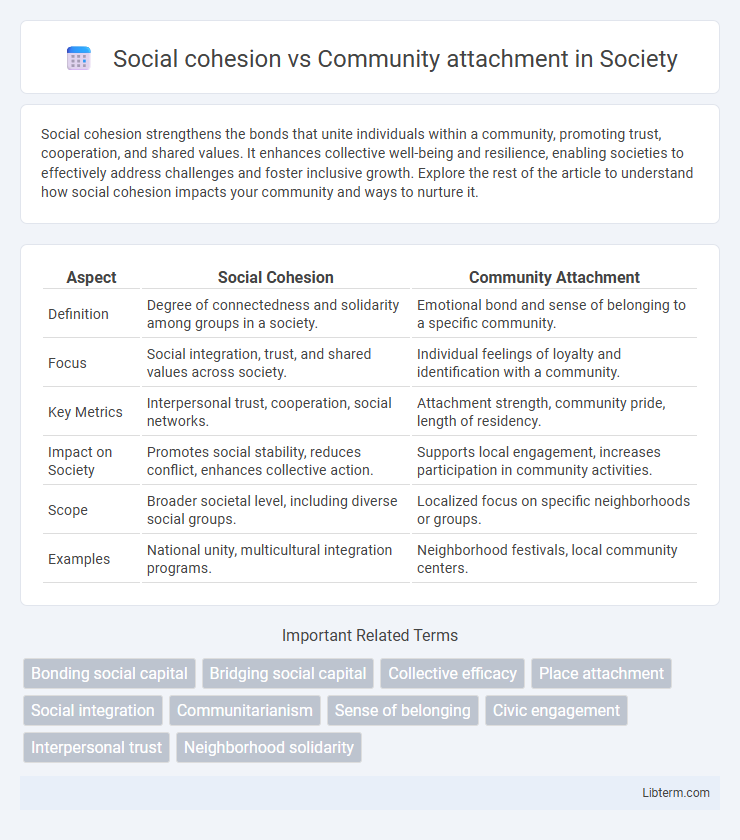Social cohesion strengthens the bonds that unite individuals within a community, promoting trust, cooperation, and shared values. It enhances collective well-being and resilience, enabling societies to effectively address challenges and foster inclusive growth. Explore the rest of the article to understand how social cohesion impacts your community and ways to nurture it.
Table of Comparison
| Aspect | Social Cohesion | Community Attachment |
|---|---|---|
| Definition | Degree of connectedness and solidarity among groups in a society. | Emotional bond and sense of belonging to a specific community. |
| Focus | Social integration, trust, and shared values across society. | Individual feelings of loyalty and identification with a community. |
| Key Metrics | Interpersonal trust, cooperation, social networks. | Attachment strength, community pride, length of residency. |
| Impact on Society | Promotes social stability, reduces conflict, enhances collective action. | Supports local engagement, increases participation in community activities. |
| Scope | Broader societal level, including diverse social groups. | Localized focus on specific neighborhoods or groups. |
| Examples | National unity, multicultural integration programs. | Neighborhood festivals, local community centers. |
Understanding Social Cohesion: Key Concepts
Social cohesion reflects the strength of relationships and sense of solidarity among community members, driven by trust, shared values, and cooperation. Community attachment measures individuals' emotional connection and commitment to their local area, influencing their participation and well-being. Understanding social cohesion involves analyzing social networks, inclusion, and collective identity to foster resilient and supportive communities.
Defining Community Attachment in Modern Society
Community attachment in modern society reflects individuals' emotional connections, sense of belonging, and identification with a specific place or group, influencing local participation and well-being. It differs from social cohesion, which broadly encompasses the overall trust, solidarity, and cooperation among diverse groups within a population. Strong community attachment fosters resilience and civic engagement by creating meaningful social ties rooted in shared values and experiences.
Core Differences Between Social Cohesion and Community Attachment
Social cohesion refers to the strength of relationships and the sense of solidarity among members of a society, emphasizing shared values, trust, and social harmony. Community attachment focuses on the emotional connection and sense of belonging individuals feel toward their specific community, highlighting personal identification and local pride. The core difference lies in social cohesion's broader societal scope and collective unity versus community attachment's localized, individual-centered emotional ties.
The Role of Trust in Social Cohesion
Trust serves as a fundamental pillar in fostering social cohesion by enabling cooperation, reducing conflicts, and strengthening shared norms within communities. High levels of interpersonal and institutional trust enhance collective efficacy, thereby promoting social integration and mutual support among community members. Empirical studies demonstrate that trust significantly mediates the relationship between community attachment and social cohesion, highlighting its critical role in sustaining harmonious and resilient social networks.
Emotional Bonds and Community Attachment Explained
Emotional bonds play a crucial role in shaping community attachment by fostering a sense of belonging and trust among residents. Social cohesion reflects the overall strength of relationships and shared values that unify a community, while community attachment emphasizes personal connections and emotional investment in local surroundings. Understanding these dynamics reveals how emotional ties drive individuals' commitment to their neighborhoods, influencing social stability and collective well-being.
Social Networks: Foundations of Cohesion and Attachment
Social networks serve as the foundational framework for both social cohesion and community attachment by facilitating interactions and shared norms among individuals. Strong, interconnected social ties within networks enhance trust, reciprocity, and collective identity, which are critical for cohesive societies and a sense of belonging. The density and quality of relationships within social networks directly influence the degree of attachment individuals feel toward their community and the overall stability of social cohesion.
Impact of Diversity on Social Cohesion
Diversity influences social cohesion by challenging shared norms and values, which can either weaken trust within communities or foster inclusive practices that enhance collective identity. Studies indicate that higher ethnic heterogeneity may reduce interpersonal trust, but this effect is mitigated by strong institutional support and proactive community engagement. Effective social policies promoting intercultural dialogue and equitable resource distribution significantly improve both social cohesion and community attachment.
Measuring Community Attachment: Tools and Metrics
Measuring community attachment involves assessing residents' emotional bonds and sense of belonging using tools like surveys, focus groups, and social network analysis. Key metrics include trust levels, participation in local activities, and commitment to community goals, which help differentiate community attachment from broader social cohesion indicators. These quantitative and qualitative methods provide insights into the depth of individual connections within communities, essential for targeted social development policies.
Enhancing Social Cohesion and Community Attachment: Effective Strategies
Enhancing social cohesion and community attachment involves fostering trust, shared values, and active participation among diverse groups. Strategies such as inclusive public spaces, collaborative events, and transparent communication channels strengthen interpersonal bonds and collective identity. Implementing community-driven initiatives and supporting local leadership further solidify social networks and promote a resilient, connected society.
Social Cohesion vs. Community Attachment: Implications for Policy and Practice
Social cohesion reflects the strength of relationships and the sense of solidarity among members of a society, while community attachment emphasizes individuals' emotional connection and commitment to their local area. Policies targeting social cohesion should prioritize fostering trust, inclusivity, and shared values across diverse groups to enhance collective well-being and reduce social fragmentation. Practice approaches that build community attachment focus on strengthening place-based identity and social networks to encourage active participation and support for local initiatives.
Social cohesion Infographic

 libterm.com
libterm.com